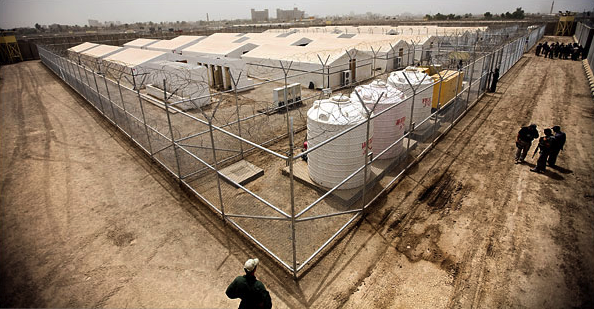I recently participated in a conference on the prospects and challenges of democracy in the modern world. One of the primary issues for discussion concerned the appropriate and effective constitutional mechanisms for advancing the goals of democratization in emergent democracies, and in particular, the role that the rule of law might play in such a process. One of the questions posed in this context was, “what does the rule of law look like”? The question is not as odd as it might at first seem, for the “rule of law” is not just a thing to be envisioned, but a legal concept, a frame through which we envision–literally see–the political and juridical world. And, of course, as we see the world, so are we inclined to engage it and to act in it.
The NYT recently featured this picture of the “Rule of Law Complex,” which it characterized as “an unusual measure to help implant the rule of law” in “a city plagued by suicide bombers and renegade militia.”
While constitutional democracies depend upon the rule of law, not all governments that employ a rule of law are constitutional democracies. And the problem with a democratic rule of law, as with democracy more generally, is that it relies fundamentally upon a modicum of popular or public trust in its ministrations. Where such trust is lacking, the rule of law can only survive by virtue of sheer force or other “unusual measures.” As this photograph indicates, Baghdad’s “Rule of Law Complex” rests precariously between contemporary Iraqi society–the troubled world of Sunni and Shiite fears and suspicions of one another–and the occupation by imperial force. Here, the rule of law is isolated from the larger society, with Central Baghdad just barely visible on the distant horizon. Contained and fortified by 10 foot high fences sporting razor wire, the encampment appears rather more like a prison compound than a government “complex,” with armed guards securing its boundaries. The irony, of course, is that prisons are designed to keep its detainees under surveillance as part of the process of protecting those on the outside from those on the inside. Here, that function is reversed, as the rule of law is quarantined (and protected) from the outside world—more a fort, perhaps, than a prison.
The real question posed by the photograph is who is doing the watching? And what are they seeing—what exactly does the rule of law look like? What does it envision? For the rule of law to gain the traction necessary to a functioning constitutional democracy in Iraq, one might imagine that the most important viewers here would be Iraqi citizens, though what exactly they might need to see in order to coach their trust in an imperial and imposed legal system is not easy to know from our ethnocentric, Judeo-Christian, judicial world view. But this photograph seems to tell a different story, with a different purpose in mind. The viewer is decidedly western, not Iraqi, and the goal has less to do with creating identification with the rule of law than with reinforcing western attitudes concerning the uncivilized and threatening conditions of a world “plagued by suicide bombers and renegade militias.” Note, for example, that the camera is positioned along a west-to-east axis, with Central Baghdad sitting to the west of the complex (a point emphasized by the NYT reporter). The viewer is thus literally situated to see from a western perspective. But more, the viewer is framed figuratively by a modernist aesthetic that incorporates many of the conventions that anthropologist James C. Scott affiliates with “seeing like a state.” The image is shot from a high angle and at some distance from the event, thus encouraging the perspective of a neutral spectator who can neither be harmed by nor affect the action unfolding below. Such distancing separates the viewer from the scene both physically and emotionally, substituting a topographical perspective that encourages the rational and strategic calculation of actions and events, rather than an emotional identification with either. The appeal to a strict, instrumental rationality is further invoked by the functionalist and stark geometrical design of the complex, underscored by the trajectory and perspective of the fence as it draws our line of sight to the distant and barely visible Baghdad.
The photograph thus locates the “rule of law” within a western perspective for modern eyes. One might even imagine the nineteenth-century American frontier with military forts used to protect “settlers” from the threat of indigenous forces in the “march of the flag” ever westward. The flag now marches in a different direction, but the conclusion seems obvious: Their present is our past! We can only wonder how far the analogy will extend.
Photo Credit: Benjamin Lowy/New York Times

[…] few weeks ago I called attention to how the attempt to institutionalize the “rule of law” in Iraq was encoded […]
[…] sluice of U.S. popular culture circa 1950, but given the ways in which the Bush administration has framed the intervention in Iraq from the very beginning as an extension of our history as a gunfighter […]